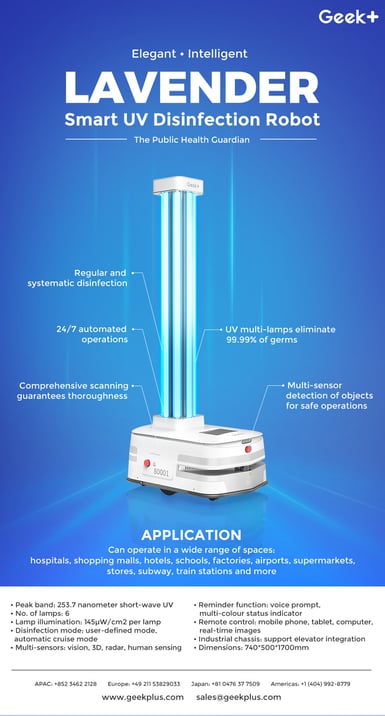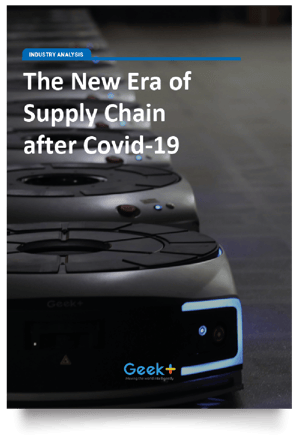Disinfection Robots: The World Health Guardian
.png?width=865&name=Disinfection%20Robots_%20The%20World%E2%80%99s%20Public%20Health%20Guardian%20(2).png)
The world has witnessed an upswing in the deployment of disinfection robots, an adamant attempt to combat the relentless Covid-19. According to the International Federation of Robotics (IFR), Chinese hospitals have recently ordered more than 2,000 disinfection robots and the units now operate in more than 40 countries throughout Asia, Europe and the U.S. The use of disinfection robots has been growing steadily over the past few years due to the spiraling demand for hygiene globally across various sectors. A study conducted by Mordor Intelligence, a market research and consulting firm, predicts a 10.2% Compound Annual Growth Rate (CAGR) growth in the disinfection robot market between 2020 and 2025.
Types of disinfection robots
To better understand how disinfection robots work, it is helpful to recognize that there are two main types, namely ultra-violet (UV) disinfection robots and hydrogen peroxide vaporization (HPV) robots. The former employs ultra-violet rays and is capable of destroying 99.99% of all microorganisms in a room within a short span of 10 to 25 minutes, depending on the model of the robot and the area of the room. HPV robots, on the other hand, work by utilizing oxidative processes to kill microorganisms. The hydrogen peroxide solution is automatically sprayed and atomized to a specific concentration. This ensures that the disinfectant is able to penetrate small gaps that are hard to access by regular cleaning work. While the room must be empty during disinfection for both types of robots, there are no detrimental effects from the UV rays nor hydrogen peroxide solution and these robots are perfectly safe to deploy.
.png?width=2560&name=Disinfection%20robots%20(3).png)
Benefits & applications of disinfection robots
As medical institutions seek hands-free methods to disinfect environments and contain the spread of bacteria and viruses, disinfection robots are in high demand and are widely utilized in terminal cleaning of hospitals and intensive care units where Hospital Acquired Infections (HAI) are prevalent. According to the US Centers for Disease Control and Prevention, 1 in 25 patients in acute care hospitals contract at least 1 HAI and every year, 75,000 deaths are attributed to HAIs. Moreover, in light of the Covid-19 outbreak, hospitals are placing even greater emphasis on sanitation and are thus turning to disinfection robots. Since they can be operated remotely, there's no need for manual labor, which mitigates the risk of infection of front-line medical professionals while freeing them up for other more critical tasks.
Aside from hospitals, public agencies and private business owners have also increased their uptake of disinfection robots to ensure the safety of public facilities and workplaces, without incurring additional labor costs. In Hong Kong, HPV disinfection robots are now utilized to sanitize the carriages of the city’s Mass Transit Railway (MTR), which transports millions of passengers per day. Meanwhile, Chinese retail giant JD.com has started its development of robots to handle disinfection and inspection tasks.
Recently, Geek+ has also announced the launch of its very own disinfection robots, named Jasmin and Lavender. Jasmin, a Smart Spray Disinfection Robot, utilizes a disinfectant spray port to swiftly deliver a delicate and uniform spray and realize a 4-6 log kill rate. What sets it apart from regular HPV robots is that it is capable of supporting various disinfection liquids, e.g. hydrogen peroxide, peracetic acid and chlorine dioxide. Conversely, Lavender is a Smart UV Disinfection Robot which boasts UV multi-lamps that kill 99.99% of germs. Both robots are equipped with multi-sensors to detect objects for safe operations and promises 24/7 automated operations as well as thoroughness through comprehensive scanning. Moreover, they can safely operate in a wide range of spaces such as shopping malls, hotels, schools, warehouses, offices, airports, hospitals, supermarkets etc.


In closing, disinfection robots will play an even more significant role in the coming years as organizations all over the world increasingly adopt these public health heroes. End-user applications of disinfection robots are also expanding, and it is exciting to anticipate how robotics will be further integrated into our lives.
If you want to know more about the key trends after Covid-19, please download our latest white paper:
About Geekplus
Geekplus is a global leader in mobile robotics technologies. We develop innovative robotics solutions for order fulfilment. More than 850 global industry leaders use our solutions to realize flexible, reliable, and highly efficient automation for warehouses and supply chain management.
Media Contact
Marie Peterson, VP International Marketing & Communications
Marie.peterson@geekplus.com


